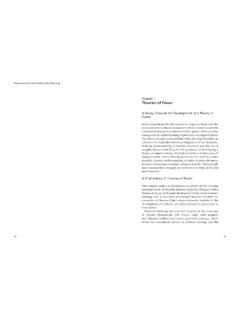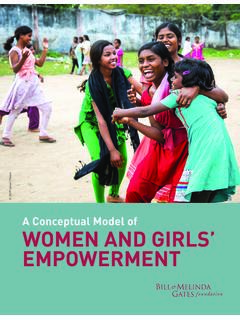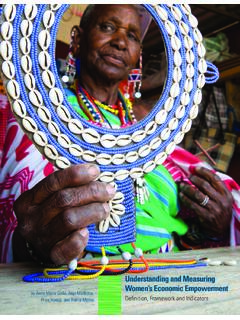Transcription of Empowering Women in the Rural Economy
1 POLICY GUIDANCE NOTESDECENT WORK IN THE Rural ECONOMYE mpowering Women in the Rural EconomyWomen play important roles in the Rural Economy as farmers, wage earners and entrepreneurs. They also take responsibility for the well-being of the members of their families, including food provision and care for children and the elderly. Rural Women s unpaid work, particularly in poor households, often includes collecting wood and water. Women from indigenous and grassroots communities are often also custodians of traditional knowledge, which is key for their communities livelihoods, resilience and culture. Yet, Women in Rural areas face constraints in engaging in economic activities because of gender-based discrimination and social norms, disproportionate involvement in unpaid work, and unequal access to education, healthcare, property, and financial and other services.
2 They are also disproportionately vulnerable to the impacts of environmental disasters and climate change. Promoting and ensuring gender equality, and Empowering Rural Women through decent work and productive employment, not only contributes to inclusive and sustainable economic growth, but also enhances the effectiveness of poverty reduction and food security initiatives, as well as climate change mitigation and adaptation efforts. The International Labour Organization (ILO) s Decent Work Agenda offers an integrated framework for Rural Women s empowerment , underpinned by international labour standards, social dialogue and the recognition that Rural Women play a key role in climate Women in the Rural Economy31.
3 Rationale and justification The ILO estimates that Rural Women comprise one-quarter of the world s population. Women also make up 41 per cent of the world s agricultural labour force, a ratio that rises to 49 per cent for low-income countries. In many South-East Asian and sub-Saharan African countries, more than 60 per cent of working Women are engaged in the agricultural Significant numbers of Women in the Rural Economy work as subsistence farmers, small-scale producers, own-account workers, and in plantations and agro-industries, but Women in Rural Economy are also employed in other sectors, such as education, tourism and domestic work. In some countries, for instance in Latin America, Women are increasingly engaged in non-agricultural sectors or occupations, with positive effects on their Yet, in others, there is a trend towards an increasing role of Women in agriculture,3 which has been explained by a higher propensity of men to migrate out of Rural areas and to shift to off-farm Men are moving out of agriculture to a larger extent than Women , to be replaced by Women joining the agricultural labour force beyond subsistence and smallholder their crucial roles in the Rural Economy .
4 Women face inequalities and challenges that hinder their access to decent work opportunities and improvements to their productivity. About 68 per cent of working Women in extreme poverty operate in the agricultural sector,5 the other sectors being fisheries, forestry, handicrafts and livestock raising. Women tend to be involved in more than one economic activity simultaneously, and take up informal and unprotected work in the absence of alternative means of generating income. Rural Women spend more time than urban counterparts, and than men, on reproductive and household work, including time spent collecting water and fuel, husking, processing food and caring for children and the challenges that Women face in the Rural Economy include lack of information on job availability, as well as opportunities for training and education, limited access to property, land6 and financial and non-financial services.
5 Much of this is linked 1 ILO: ILOSTAT, ILO: Working in the Rural areas in the 21st century: Reality and prospects of Rural employment in Latin America and the Caribbean, Regional Office for Latin America and the Caribbean (Geneva, Thematic Labour Overview No. 3, 2017), p. See for example WB: Feminization of agriculture in the context of Rural transformations: What is the evidence? (Washington, DC, 2016), including the report s extensive ILO: Decent work for food security and resilient Rural livelihoods, Portfolio of policy guidance notes on the promotion of decent work in the Rural Economy , Sectoral Policies Department (Geneva, 2016).5 ILO: World Employment Social Outlook 2016: Transforming jobs to end poverty (Geneva, 2016).
6 6 The average rate of female agricultural land ownership is less than 20 per cent in developing countries (Rome, FAO, 2010).to gender-based inequality and discrimination. Social norms on the role of Women in the family and preconceived ideas of what is appropriate work for Women are among factors perpetuating sectoral and occupational segregation between Women and men and further reinforcing inequality. Rural Women workers are less likely to engage in wage employment compared to men and to Women in urban areas, and when they do, they tend to earn less than their male Rural Women , on average, are paid 25 per cent less than men, and they typically work longer They are also often engaged in labour-intensive work in difficult conditions, which lack occupational safety and health measures, and social Women agricultural workers are particularly vulnerable to sexual or other violence and Women s presence in workers and employers organizations remains low.
7 Leading to a lack of voice and representation in policy-making and programme slavery also disproportionately affects Women and girls, who account for million or 71 per cent of all This includes forced labour in sectors such as agriculture, domestic work and the sex industry, where most forced labour is found. Particularly in agriculture, forestry and fishing, figures on sex distribution of victims of forced labour highlight that nearly 32 per cent of the victims are female. At the same time, the persistence of a serious deficit in decent work opportunities in the Rural Economy for Women , contributes towards the push factors that force some Women to migrate and many to rely on the informal Economy in search of income generation opportunities.
8 These often tend to be in areas and sectors where Women are at a high risk of being discriminated against and in Rural areas are especially vulnerable to the impacts of climate change, such as drought, floods and deforestation because of cultural norms and the inequitable distribution of roles, resources and power. Women make up the majority of the world s poor and are more dependent than men on natural resources for their livelihoods and survival. In the context of climate change, traditional food sources become more unpredictable and scarce. Women face loss of income as well as harvests often their sole source of food and income. 7 FAO: The state of food and agriculture 2010-2011 I: Women in agriculture: Closing the gender gap for development (Rome, 2011).
9 8 FAO, IFAD and ILO: Gender dimensions of agricultural and Rural employment: Differentiated pathways out of poverty - Status, trends and gaps (Rome, 2010).9 R. Gopalakrishnan and A. Sukthankar: Freedom of association for Women Rural workers: A manual (Geneva, ILO, 2012).10 ILO: Meeting of Experts on Violence against Women and Men in the World of Work, Geneva, ILO, Walk Free Foundation and IOM: Global estimates of modern slavery (Geneva, 2017). Empowering Women in the Rural Economy4 Related increases in food prices make food less accessible to poor people, in particular to Women and girls, whose health has been found to decline more than male health in times of food shortages. Furthermore, Women are often excluded from decision-making on access to, and the use of, land and resources critical to their This can increase the burden of unpaid agricultural and household work on girls and Women , leaving them with less time for education and training, and reducing their opportunities to access paid work.
10 In Africa, climate change is now threatening the viability of subsistence farming and the survival of millions of Rural dwellers, 75 per cent of whom are A 2017 Lancet study has also observed that global labour capacity in Rural populations exposed to temperature change is estimated to have decreased by per cent between 2000 and 2016. The study emphasizes that higher temperatures pose profound threats to occupational health and labour productivity, particularly for people undertaking manual, outdoor labour in hot areas. More specifically, the study observes that such losses of labour capacity have important implications for the livelihoods of individuals, families, and communities, especially those relying on subsistence At the same time, exclusionary response and recovery efforts to natural disasters can also have disproportionate effects on Women , and can increase or reinforce existing The situation is even more challenging for Women attempting to recover from environmental disasters16 because of their limited access to technology, knowledge and productive For instance.













